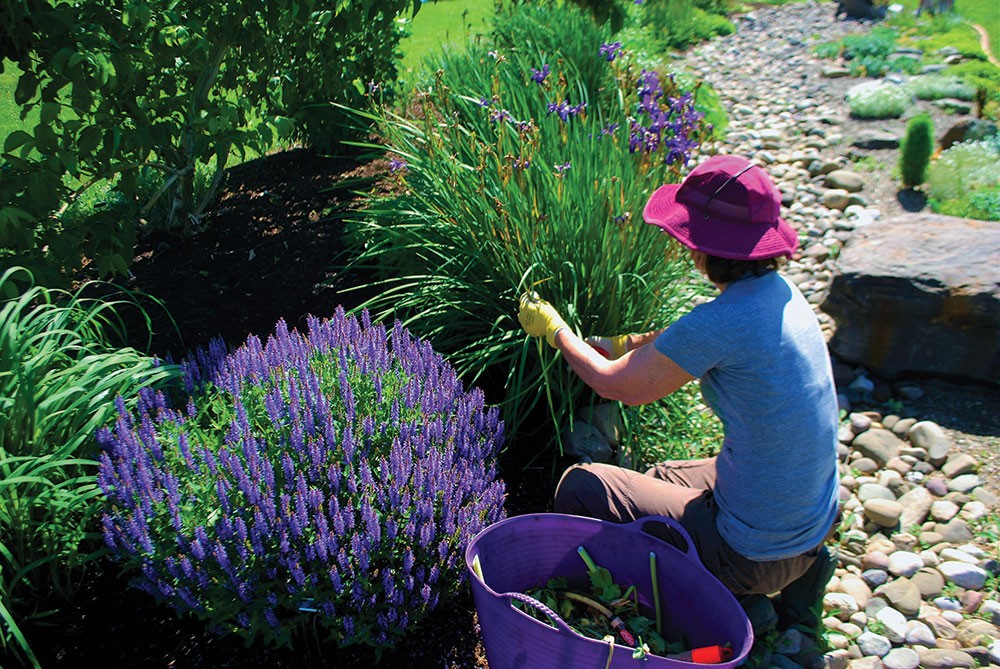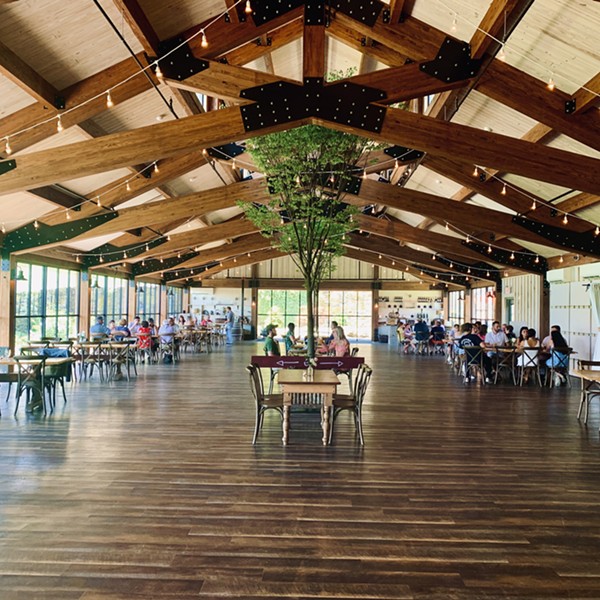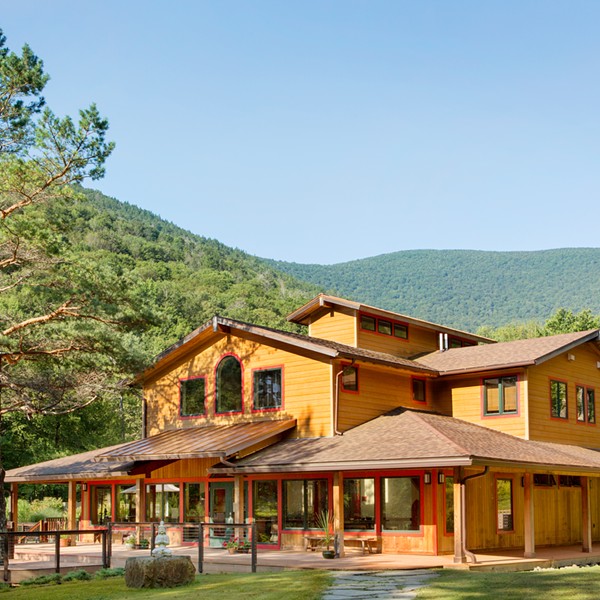
From Denver to Stone Ridge
The Xeriscape Garden on the SUNY Ulster campus in Stone Ridge is as colorful and lush as any garden in the Hudson Valley. People who happen upon it would not likely guess that the garden is totally geared toward minimal water usage. It demonstrates dozens of water-efficient plants for the Hudson Valley; they need not only be the cactuses and yucca and other desert plants that many of us picture when we hear "xeriscape" or "water-wise gardening." You can't miss the garden, on your left as you come into the heart of campus, across the road from the Hasbrouck Building. It's a series of curvy, raised beds with dozens of different varieties of plants, from small trees to petite annuals.
The Xeriscape Garden is cared for by the Cornell Cooperative Extension (CCE) of Ulster County Master Gardeners (MGs) and is both a demonstration and teaching garden where MGs host a variety of workshops (see sidebar) and tours. The garden is also open to the public anytime the SUNY Ulster campus is open. It was installed by MGs in 2000 in conjunction with the college. In 2004, the impressive garden was awarded the NE Regional Master Gardener Conference Search for Excellence Award (First Place for New York State).
The word "xeriscape" comes from the Greek xeros meaning "dry" in the formation of compound words. (Note that xeriscape is pronounced zair-uh-scape, not ze-ro-scape). A xeriscape is a landscape designed for minimal water use. A xeriphyte is a plant adapted to grow in dry conditions. The concept of xeriscaping originated in Denver, Colorado, circa 1981, when drought was severely taxing the water supply, and its appeal has spread internationally.
We in the Hudson Valley are fortunate to receive an annual average precipitation of about 42 inches, but we are not immune to drought. According to the National Oceanic and Atmospheric Administration records, the Hudson Valley has experienced 15 periods of drought since 1895, or about one every seven and a half years. Each drought period lasted on average five months. Even putting aside the question of how the next drought (and our unrestrained water usage) could tax our water supply, wouldn't it be nice not to have to water so much (or at all)? To have at least one of your gardens be resilient to that extent?
Principles for the Water-Wise
Xeriscaping is predicated on seven basic principles, most of which are not unique to xeriscapes, but rather could be applied to any landscape. For instance, among the principles, good planning and design, soil preparation, use of mulches, and appropriate maintenance are important for any garden.
Good planning and design includes performing an assessment of your site so you know its soil properties, sun/shade/wind exposure, the presence of microclimates (such as a warm nook by the house), limitations such as underground utilities, and the like. Soil preparation means making sure your soil has adequate organic matter to be able to retain as much moisture as possible (yet still freely drain). A soil test through CCE can reveal existing organic matter content along with pH and micro- and macronutrient content, which will help guide you in making the soil better (but the bottom line is that most soil deficiencies can be addressed by adding more organic matter).
A third principle is choosing water-efficient plants and grouping together those that have similar cultural needs. So for instance, plants that are ultra-drought-tolerant, such as ornamental grasses, Russian sage, and perennial salvias, could be grouped in the same bed, since irrigation will not be necessary for them (once they are established).
Knowing how to effectively use lawns is another principle. There's one school of xeriscape thought—more common out West—that because successful lawns are water-intensive, we should limit their area greatly. However, in most Hudson Valley growing seasons, we have substantial rainfall, or when we don't, lawns bounce back well from dry periods. Lawns can provide the benefits of social space, erosion control, cooling, and reducing sun glare.
Efficient irrigation is another principle of water-wise gardening. Drip irrigation is widely considered the most efficient system in our climate, delivering water more precisely to plant roots than aerial forms of irrigation. In tandem with that is the need for mulch: bark, compost, patented mixes of bark and compost, straw, leaf mulch—it takes many forms. Mulch should be applied about three inches in depth, with the mulch pulled back from immediate contact with plant stems. Lastly, there is the principle of appropriate maintenance. Perhaps the most obvious demonstration of this is that well-weeded beds mean that chosen plants are not competing with weeds for available water.
For me in my dry, south-facing garden in poor soil (sandy/rocky fill), the two most important principles that have allowed me to water minimally have been choosing water-efficient plants and mulching.
A Wealth of Water-Wise Plants
When you take a tour of the Xeriscape Garden at SUNY Ulster, your MG guide will give you a comprehensive list of recommended plants—those annuals, perennials, ornamental grasses, and woody plants that have been used successfully in the garden.
Water-efficient annuals on the "successes" list include ageratum, amaranth, celosia, cosmos, dusty miller, flowering tobacco, gazania, marigolds, portulaca, annual salvia, strawflower, verbena, and zinnias. Annuals should be watered for several weeks to get some root establishment before they are on their own, water-wise.
Water-efficient perennials on the list include artemisia, aster, black-eyed Susans, blazing star, butterfly weed, catmint, daylilies, false indigo, lavender, penstemon, red hot poker, sedums, tickseed, and yarrow. By dint of rain or hand watering, they will need one inch of water per week during their first year in order to get well established.
Most ornamental grasses are extremely drought-tolerant. Among the best are blue oak grass, feather reed grass, maiden grasses, and switchgrass. Like perennials, they need to receive regular rainfall or watering through the first season.
Among the most water-efficient woody plants are butterfly bush, juniper, potentilla, rugosa roses, trumpet vine, and witch hazel. Where rainfall fails to, provide one inch of water per week the first season in order to get good root establishment.
The garden is interesting for many months of the year, but longtime MG Cheryl Alloway, who did the original design for it, encourages people to visit on a summer evening, "to see the swaying ornamental grasses at sunset."
Learning in the Garden Worksop Series
Located at the Xeriscape Garden on SUNY Ulster on campus
Rain Gardening: July 16 at 10am. Free.
Pollinator Gardening: August 20 at 10am. Free.
Master Gardener Plant Sale: September 17 from 9am to noon.
Invasive Plants Cleanup for your Garden: October 15 at 10am. Free.
To inquire about tours of the Xeriscape Garden, contact Ulster County CCE Community Horticulture Educator Dona Crawford at (845) 340-3990 ext. 335 (email: [email protected])
Every Spring there is also a Perennial Division class. "That is our 'Huck Finn' event, because the public learns how to divide perennials, they take some home and the garden gets a spring makeover," Crawford says.















